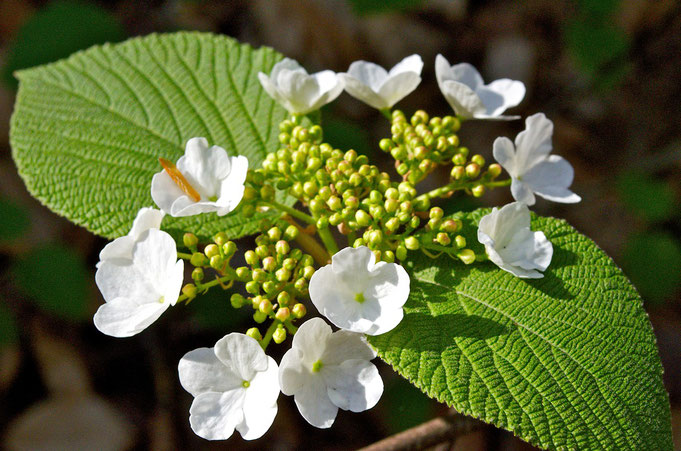A Unique Native Viburnum

Hobblebush (Viburnum alnifolium - syn. lantanoides) blooms in early May in the woods of Distant Hill Gardens. It is a shade loving deciduous shrub growing 6–12 ft (2–4 meters) high, with branches that will root if they touch the ground. These rooted branches form obstacles which can trip (or hobble) walkers – hence the common name.
Hobblebush succeeds well at growing in deep shade. Developing leaves before the neighboring trees leaf out gives this Viburnum access to the suns rays for two to four weeks before the over-story leaves have fully expanded. The large heart-shaped opposite leaves, up to 8 inches long, act as large solar collectors in the dark understory.
This eastern North America native has developed a number of interesting adaptations that enable it to not merely survive, but to flourish in the cold and shade. It has an antifreeze in its leaves that reduces the freezing point to 23℉ (-5℃), enabling the growing plant to withstand temperatures that would damage most other plants. At night, hobblebush maintains a low respiration rate compared to other plants using less energy. And the showy flowers in the outer ring are sterile while the small greenish flowers of the inner cluster are fertile. This enables the plant to produce flowers that are attractive to pollinators while using less energy.
The flowers are 3 inches or more across, followed by fruits that change in color from red to dark purple in late summer. The flowers provide nectar and the leaves provide food for the Celastrina ladon (Spring Azure) butterfly and its caterpillar. The fruits, leaves and twigs of this beautiful Viburnum are food for a large number of birds and mammals. In fact, one of its other common names is Moosewood.
For more on this interesting native shrubs read this Northern Woodlands article.
And for more photos on this rather extraordinary native plant and its survival mechanisms read this blog 'Hiking with Chuck'

